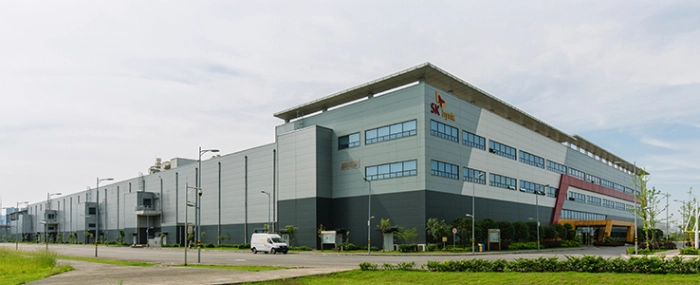
© SK hynix (illustration purpose only)
Components |
NAND Flash revenue shows mere 2.9% QoQ decline in 4Q/20
The quarterly total revenue of the NAND Flash industry came to USD 14.1 billion in 4Q20, showing a QoQ drop of 2.9%, according to TrendForce’s latest report.
The total bit shipments of the NAND Flash industry in 4Q/20 registered a QoQ increase of nearly 9%. This gain for the most part offset the negative impacts brought about by the QoQ decline of nearly 9% in the overall ASP of NAND Flash products, as well as by the unfavorable exchange rates that impaired some suppliers’ performances. At the same time, clients in the server and data center segments continued their inventory reduction efforts that had begun in 3Q/20. Since their procurement drive remained fairly weak, contract prices of NAND Flash products continued their decline as well. However, NAND Flash suppliers were receiving substantial orders from OPPO, Vivo, and Xiaomi. On the whole, the strong demand in the smartphone segment mostly compensated for the weak demand in the server and data center segments. In the notebook computer segment, Chromebook devices were the primary sales driver, but the storage components of most Chromebooks are low-density solutions, meaning related NAND Flash demand is somewhat limited.
Turning to 1Q/21 (this quarter), the bit output of the NAND Flash industry continues to grow significantly due to two factors. First, Samsung and YMTC are actively expanding production capacity. Second, all suppliers are eager to migrate to the more advanced stacking process. On the demand side, PC and smartphone brands have kept stocking up on components. However, they have also slightly corrected down their demand as the first quarter is the traditional off-season. As for clients in the server and data center segments, they have yet to restart large-scale procurement even though their inventories have generally returned to a healthy level. As such, during price negotiations, NAND Flash suppliers still expect the oversupply situation in the market to intensify and thereby further drive contract prices of NAND Flash products downward. Therefore, NAND Flash suppliers’ revenues are projected to undergo a QoQ decline in 1Q/21.
Samsung
Two factors helped Samsung’s performance in the NAND Flash market during 4Q/20. First, Chinese smartphone brands (with the exception of Huawei) continued to aggressively build up their component inventories so as to fight for more market share. Second, PC OEMs released more upside orders than anticipated because of the further demand growth for notebook computers. Samsung’s NAND Flash bit shipments in 4Q/20 rose by 7-9% QoQ as a result of the strong procurement momentum in the smartphone and PC segments. However, the ASP of its NAND Flash products dropped by more than 10% QoQ for the same period. Although clients in the data center segment did begin sending out orders for servers and components at that time, their demand was still very limited. As for clients in the enterprise server segment, they were mainly focused on inventory reduction. With the market leaning toward oversupply, Samsung had to lower prices and thereby experienced a revenue decline. Compared with 3Q/20, Samsung’s NAND Flash revenue fell by 3.4% to USD 4.644 billion.
Regarding production and technology plans, Samsung this year will be the leader among NAND Flash suppliers in raising production capacity. Besides continuing to expand the production capacity of the Xi’an Fab 2, Samsung will also set up a production line for 3D NAND Flash at P2L (in the Pyeongtaek campus). Most of Samsung’s NAND Flash products are still based on the V5 (92L) process at this moment. However, the supplier will significantly raise the output share of NAND Flash from the V6 (128L) process this year. The application of the V6 process technology will expand to more of its offerings for SSDs and UFS solutions.
Kioxia
Following the end of Huawei’s stock-up activities, Kioxia was unable to fully regain the demand for its mobile NAND Flash products through orders from other Chinese smartphone brands in 4Q/20. At the same time, the supplier was affected by the weak demand for enterprise SSDs. On the other hand, there were other sources of demand such as notebook computers and game consoles. Consequently, Kioxia’s bit shipments in 4Q/20 still registered a small increase. As for the ASP, Kioxia experienced a QoQ decline of 8-10% because of the general oversupply situation. On account of these factors, Kioxia’s NAND Flash revenue slid by 11.4% QoQ to USD2.749 billion for 4Q/20.
Regarding production and technology plans, Kioxia will gradually expand the production capacity of K1. As for the construction of new fabs, Kioxia is staying with its plan to begin building Fab 7 in Yokkaichi and K2 in Kitakami in 1Q/21. These fabs, which will be producing BiCS6 or more technologically advanced products, are expected to start contributing to the supplier’s output sometime in 2022. Technology migration will also be the main driver of its bit output growth. Currently, the majority of Kioxia’s NAND Flash products are still manufactured with the 96L BiCS4 process. Going forward, the supplier intends to raise the shipment share of 112L BiCS5 products this year.
Western Digital
Western Digital saw the ASP of its NAND Flash products drop by 9% QoQ for 4Q/20 as its clients in the server segment were reducing their inventories. On the other hand, the sales of its channel-market products continued to grow, and the robust demand for notebook computers led to an impressive shipment result for its client SSDs. Western Digital’s bit shipments in 4Q/20 increased by 7% QoQ. This roughly compensated for the decline in the ASP. All in all, the supplier posted a QoQ drop of just 2.1% in its revenue to USD2.034 billion.
Concerning its activities, Western Digital will be collaborating with Kioxia in the construction of Fab 7 and K2. The additional production capacity from these two plants will help the allied suppliers to deal with market competition in the future. The 96L BiCS4 process will be Western Digital’s primary technology for NAND Flash production this year. Additionally, Western Digital will be providing OEMs with samples of TLC and QLC products that are manufactured with the 112L BiCS5 process sometime between 2Q21 and 3Q/21. Western Digital’s next-generation BiCS6 process is also set to enter the production stage in 2022.
SK Hynix
SK Hynix benefited from the aggressive stock-up activities of Chinese smartphone brands in 4Q/20. Its bit shipments rose by 8% QoQ, but its ASP also dropped by 8% QoQ due to the general oversupply situation. With the decline in the ASP being canceled out by the increase in bit shipments, SK Hynix kept its NAND Flash revenue relatively constant for 4Q/20. It posted a miniscule QoQ decline of 0.2% to USD 1.639 billion.
This year, SK Hynix will rely on technology migration as the primary means of increasing bit output. The share of 128L products in its bit output came to around 30% at the end of 2020 and is expected to keep growing to surpass the output shares of 72L and 96L products in 2021. The supplier has also scheduled the launch of its 176L products for 2H/21. Regarding the acquisition of Intel’s NAND Flash plant in Dalian, the transfer of the ownership of the plant along with Intel’s SSD assets is expected to be completed by the end of this year as originally planned.
Micron
Thanks to stock-up activities of smartphone brands and the growing demand for QLC SSDs from PC OEMs, Micron posted a significant QoQ increase of 17-20% in its bit shipments for 4Q/20. However, like other suppliers, its ASP fell in the same period due to the general oversupply situation and registered a QoQ decline of 10-13%. In terms of revenue, Micron posted a QoQ increase of 2.9% to USD 1.574 billion.
On the technology front, Micron has 128L products, but unlike other suppliers’ strategies, Micron will not ship 128L products to its main clients. Instead, Micron is focusing on the development of the second-generation 176L products that will serve as its main offerings in the future. Its clients will thus bypass the 128L process and advance directly to 176L process. OEMs are expected to begin receiving samples of 176L products from Micron in 2Q/21 in accordance with the supplier’s schedule. With respect to the cell type, Micron is raising the shipment share of QLC products. Currently, more than 50% of supplier’s NVMe SSD shipments (in bit terms) are QLC products.
Intel
Intel made a recovery in its bit shipments in 4Q/20 after inventory adjustments in the data center and enterprise server segments had caused a QoQ decline of nearly 25% in 3Q/20. The procurement momentum of its clients was still fairly weak in 4Q/20, but it did pick up somewhat compared with the previous quarter. Additionally, the demand from PC OEMs continued to rise. Consequently, Intel’s bit shipments grew by nearly 25% QoQ for 4Q/20. Again like other suppliers, Intel saw its ASP drop in 4Q/20 because of the general oversupply situation. The QoQ decline came to almost 20%. On balance, Intel’s NAND Flash revenue went up by 4.8% to USD 1.208 billion for 4Q/20.
Intel will probably not make any significant changes to its existing plans for production capacity and product mix as it has sealed the deal to sell its NAND Flash business to SK Hynix. It will continue to leverage its advantage in the enterprise SSD market to push its clients to adopt 144L products. Regarding the distribution of its product shipments by technology, Intel will be raising shipment share for the 144L stacking process and the QLC architecture. To increase the output of 144L products, Intel will expand the production capacity of the Dalian plant this year. From a long-term perspective, SK Hynix will be the main beneficiary of this capacity expansion effort.
On the whole, TrendForce’s investigations find that PC OEMs have been releasing a substantial amount of upside orders since the start of 1Q/21. Although the oversupply situation is worse compared with 4Q/20, it has become more moderate than expected. Moreover, the market is anticipating that clients in the data center segment will reinitiate large-scale procurement in 2Q/21. The sentiment has thus turned more positive with respect to contract negotiations, and the general price decline has also begun to ease earlier than expected. Suppliers’ sales performances are projected to rebound rapidly in 2Q/21.
More information can be found on Trendforce's website.
More information can be found on Trendforce's website.

